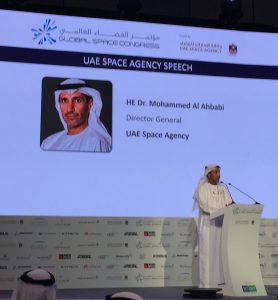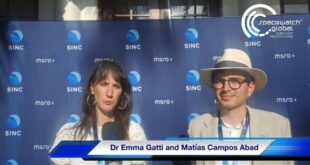 Supported by the UAE Space Agency, MilSatCom 2017 brings together the Middle East’s military communications community. Taking place on February 22nd in Abu Dhabi, the event focuses on identifying future regional needs, enhancing capabilities and developing space assets. For the past six years MilSatCom has gathered the top regional decision makers from military and security services, alongside government defence agencies and ministries, equipment providers and satellite operators.
Supported by the UAE Space Agency, MilSatCom 2017 brings together the Middle East’s military communications community. Taking place on February 22nd in Abu Dhabi, the event focuses on identifying future regional needs, enhancing capabilities and developing space assets. For the past six years MilSatCom has gathered the top regional decision makers from military and security services, alongside government defence agencies and ministries, equipment providers and satellite operators.
Satellite is a key part of any military portfolio, enabling beyond-line-of-sight connectivity and robust communications in all parts of the battlefield, right to the tactical edge.
MilSatCom is a platform for building regional satcoms capability. It demonstrates the pros and cons of commercial services, hosted payloads, dedicated military satellites and leasing. It helps users lower costs and streamline procurement processes, ensuring that they can match future requirements with domestic and international commitments, providing cost effective satcom and long-distance communications capacities for regional forces.

This year, the programme is a packed one and will focus upon a wide range of topics, with high level speakers who will give their perspective on the current state of the MilSatCom environment in the Middle East and what is available to the armed forces. HE Mohammed Al Ahbabi, Director General of the UAE Space Agency will give a Keynote address on the UAE’s strategy to ensure resilient and robust military satellite communications networks. This will be followed by updates on the French Syracuse system. The afternoon sessions are sure to attract much attention:
Assessing the MilSatCom environment in the Middle East will focus on how Middle East militaries can build readiness and resilience by implementing a total, end-to-end, space and ground segment, mobile satellite service. The session will also identify future regional needs, how capabilities may be enhanced and space assets developed. There will also be discussion on the difference of the Middle East in comparison to other markets and the comparison of options for regional satcoms such as commercial services, hosted payloads and dedicated military satellites and leasing. The issue of spectrum will also be addressed as the availability of bandwidth is key to the success of any military satellite programme.
Capacity building – strengthening of MilSatCom architecture and building robust networks will look at how to achieve higher satellite capacity by improving military communication network planning and at opening up new service capabilities for government and militaries. It will explore how militaries can leverage the emerging opportunities of High Throughput Satellites and Military Ka band. The panel will also tackle the question of how to eliminate communications bottlenecks and solving the latency problem.
Understanding government and military user requirements is set to address how satellite performance can be improved through a seamless network service and how to deliver more bandwidth and higher data speeds. The requirement for bandwidth and higher satellite capacity is growing. This panel will talk about how this can be achieved in order to handle bandwidth hungry applications such as UAVs.
Commercial hosting of military payloads will examine the flexibility that commercial hosted payloads offer. It will look at integrated sensor and communication solutions; accommodating orbital location and design control and maintaining sovereign capability and control. It will also evaluate the cost benefits and downfalls of hosting versus deploying own satellites and will feature case studies from Tony Colucci, Tony Colucci, Vice President, SSL.
Full spectrum C4 with MilSatCom is set to take an in-depth look at the new Spanish MoD MILSATCOM “SPAINSAT NG” programme and its goals and roadmap. The SPAINSAT NG programme will endeavour to ensure effective command and control for beyond line-of-sight operations and to guarantee communication capability in theatres of operation lacking communications infrastructure. To achieve this, the Spanish MoD will be developing more mobile, higher capacity, better secured and better assured communications in order to unlock the potential of the network centric battlespace.
The conference will be rounded off by a session focused upon Technology and Market Outlook for Next Generation MilSatComs. This final session will cover forecasts for spending on global military communications systems and will look at the growth of the military satellite terminal market in the MEA region. Topics such as growing demand for higher frequency Ka-band terminals, supporting multi-band and/or wideband operations and future component technology choice and demand will also be covered.
Should you wish to find out more about MilSatCom Middle East, please visit the website, at www.milsatcom.me
Original published at: https://spacewatch.global/2017/02/milsatcom-middle-east/
 SpaceWatch.Global An independent perspective on space
SpaceWatch.Global An independent perspective on space

